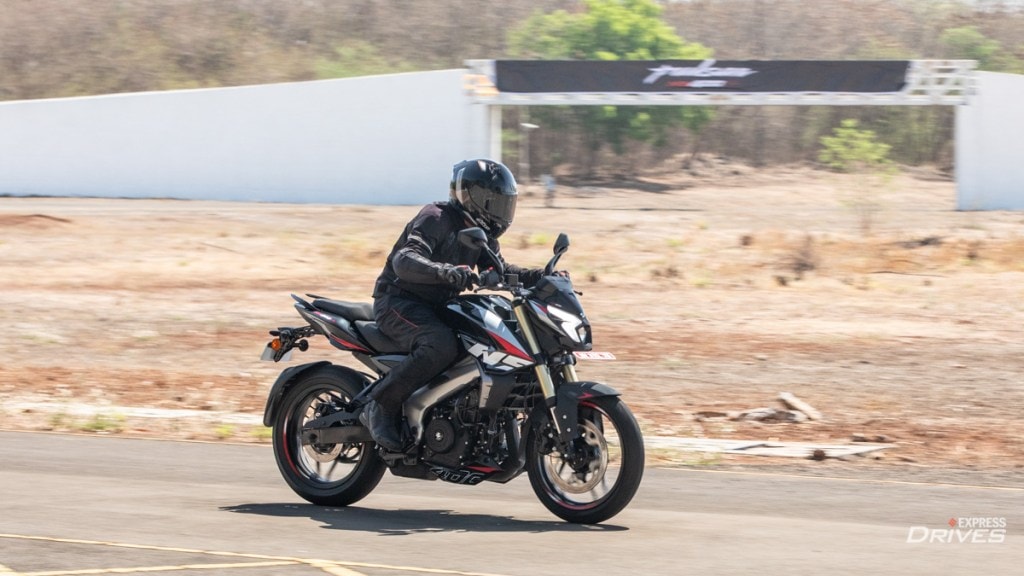The sub-500cc segment is the hottest in India right now, and with Triumph launching the Speed 400 at Rs 2.23 lakh ex-showroom, it left the industry in shock. But Bajaj has managed to shock everyone again with the new Pulsar NS400Z’s jaw-dropping price of Rs 1.85 lakh, ex-showroom.
This raises a lot of questions asking if Bajaj has cut corners in making the new NS400Z and how it is possible to offer a 400cc motorcycle at this price point. The short answer is no, Bajaj has not cut corners, and the NS400Z is a perfect example of how a sub-500cc motorcycle can carry such a price tag.
Bajaj Pulsar NS400Z first ride review: Design
The new Pulsar NS400Z is a mix of motorcycles and depends on the angle you look at it. From the front, it looks like the new Pulsar N250, that’s because the headlight unit is taken from there, while the ‘thunderbolt’ shaped DRLs give it presence. From the side profile, it looks like the NS200.
This, again, is for good reason, as the tank, side panels, and tail section are from the NS200 itself. Towards the rear, it’s the same case, and that’s how Bajaj has managed to cut costs without cutting corners with the NS400Z. There are other parts shared as well, however, the NS400Z has a 20mm shorter wheelbase than its 200cc sibling, which we will discuss in a bit.
Bajaj Pulsar NS400Z first ride review: Hardware and components
Adding to the styling are the USD forks, a new rear monoshock setup, disc brakes at both ends with dual-channel ABS, alloy wheels, and more, which can be looked up in the spec sheet. All these have come together well to offer a slightly stiff, but good ride, which we will speak about in detail.
That said, what is new with the new NS400Z is a host of electronics and ride modes, which is possible with a new ride-by-wire system. The motorcycle gets traction control, and ABS modes, while smartphone connectivity is also possible via the new colour LCD console.
Bajaj Pulsar NS400Z first ride review: Engine specifications
The engine is lifted straight out of the Dominar 400 and gets no changes. The engine makes identical power — 39 bhp and 35 Nm of torque. The gearbox is also the same, however, the rear sprocket is larger by one tooth. The only change in the department is the exhaust, which is an underbelly one, which, according to Bajaj, helps with the weight distribution.
Bajaj Pulsar NS400Z first ride review: How well is it as an overall package?
What matters is how all of the above come together as a package. On the design front, it could be polarizing, as it’s a mix of the NS and the N. The components also come together well to offer a slightly stiff ride, which in my opinion, is good. However, the most notable fact is its agility, unlike the Dominar. The underbelly exhaust and the shorter wheelbase have made it nimble.
Complementing the agility is the liner engine that loves to sit at mid-to-top revs. The gearbox is smooth and needs absolutely no effort to shift gears while the clutch itself is light. Adding to the overall experience are adjustable levers and the relaxed but slightly forward-leaned position.
Not all is good news, as there is room for improvement. The front brakes, for example, are soft, which can do with better bite. Out of the factory, the motorcycle comes with organic brake pads, and a set of sintered ones can solve this problem.
The other niggle is the instrument console, as it has too many things happening in a really small space. That said, we could not determine how well the traction control system worked because conditions were perfect that day, and we will save our comments on it when we ride the motorcycle for longer.
Bajaj Pulsar NS400Z first ride review: So what do we think?
The NS400Z has its ups and niggles, however, the pricetag blankets everything possible. The niggles don’t seem important anymore, since they can either be fixed or one can learn to live with it. If I was asked about the NS400Z, I would say it has to be on the list of motorcycles shortlisted for a test ride.
